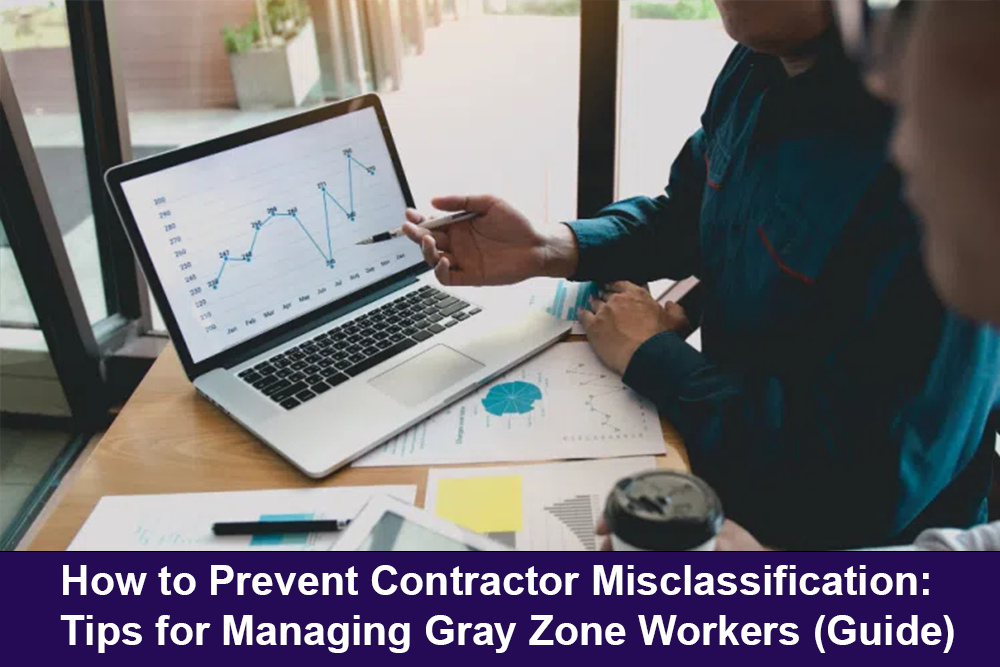10 Strategies to Reduce Contractor Compliance Risk (Guide)

If you suspect your business may be using independent contractor engagement practices that heighten your risk profile, it is important to arm yourself with an understanding of what today’s most forward-thinking companies are doing to reduce their risk.
Because regulatory authorities are giving increased attention to proper classification of independent contractors, all businesses need to revisit their independent contractor compliance policies and procedures.
Your policy should clearly state what is to be expected during the independent contractor evaluation process.
It is critical to carefully review your company’s independent contractor contact or contracts.
Overview
As the project-based economy continues to evolve, proper management of independent contractor talent will prove to be critical. If you suspect your business may be using independent contractor engagement practices that heighten your risk profile, it is important to arm yourself with an understanding of what today’s most forward-thinking companies are doing to reduce their risk. The following ten best practices can help mitigate or even eliminate the risks associated with engaging independent talent.
GATE
In this guide, you will find 10 steps you can take to reduce contractor compliance risk
1. Establish a consistent, centralized process to evaluate and onboard independent talent
Regulatory authorities are giving increased attention to proper classification of independent contractors. This should drive all businesses to revisit their independent contractor compliance policies and procedures. A good place to start is by getting a general understanding of your organization’s classification and engagement procedures. What are you doing? Who is doing it? How consistently is it being done?
It is also important to understand the extent to which your procedures are being followed. If a certain procedure is not being followed, attempt to determine if there are any common problems with or complaints about the procedure that may be causing people to work around it. With this information in hand, you can avoid creating the same problems when you institute a new procedure, thus increasing adoption and overall program success.
A good place to start is by getting a general understanding of your organization’s current independent contractor classification and engagement procedures.
2. Address disgruntled independent contractors
Your managers need to know the policies and procedures for engaging independent contractors. Before you start writing your policy, however, evaluate the adequacy of your current program. Is it businessfriendly and seamless for hiring managers? Is the talent you are engaging clear on what they need to ensure proper engagement? Has the program been adopted adequately, or is it being avoided? How accurate are your classification determinations?
Your policy should clearly state what is to be expected during the independent contractor evaluation process. Outline baseline requirements for a qualified independent contractor, such as insurance coverages and limits, contract language, and billing instructions or payment terms. The policy should also specify that all independent contractor assignments are governed by a guiding Statement of Work (SOW). It should empower hiring managers to initiate independent contractor engagements by producing an SOW that follows a consistent format—including defined beginning and end dates, expected results or deliverables, and associated payment schedules.
A clear policy should outline the baseline requirements for a qualified independent contractor, such as insurance coverages and limits, contract language, and billing instructions or payment terms.
3. Review vendor procurement practices to properly vet any small business including independent contractors
Companies often pay independent contractors through invoices and categorize them as 1099s (the tax form organizations must file to reflect payment). These small services providers are typically low in volume and are often not required to maintain the levels of insurance or contract terms of other larger vendors. This can cause problems when faced with potential lawsuits that would have otherwise been protected under a vendor’s General Liability of Errors & Omissions insurances.
It is important to review the practices associated with these vendors and try to create standardized requirements for all contracted vendors. Consider setting a standard minimum level of business insurance coverage. All of these important procedural changes should be reflected in your standard contracts.
Consider setting a standard minimum level of business insurance coverage to avoid problems with potential future lawsuits.
4. Assess your independent contractor template
It’s easy for managers to get into the habit of using a standard independent contractor template and sending it over to any new contractor who comes on board. However, this can be problematic for two reasons:
- the contract language may not include adequate protections, and
- different managers may be working from different versions of a contract template that has changed over time.
It is therefore critical to carefully review your company’s independent contractor contact or contracts. A contract template should include a few key details: the business name of the independent contractor, whether or not sub-contracting is allowed, and a clause that specifically identifies independent contractor status. While this clause does not make an independent contractor compliant by default, it’s important to make sure the contractor you are engaging understands the expectations and limitations of your relationship.
It is also important to implement a process that ensures the consistency of contracts enterprise-wide. Make sure that your independent contractor payment terms and business insurance requirements are consistent for everyone—and never waived. All non-disclosures, intellectual property rights, and noncompete clauses should be consistent and applicable. Finally, research existing contracts to make sure that certain vendors aren’t “grandfathered in” under outdated contracts that may include exceptions from your new standard.
A contract template should include a few key details: the business name of the independent contractor, whether or not sub-contracting is allowed, and a clause that specifically identifies independent contractor status.
5. Evaluate your insurance and/or employee benefit plans
Take a close look at your benefit plan documents. Do they expressly exclude groups that may be construed as contract-based workers? If not, you should modify them immediately. Only your W-2 employees may have rights to employer-sponsored benefits such as medical insurance, retirement programs, or stock plans.
It’s also wise to conduct an investigation to determine if any of your existing independent contractors or small services providers are receiving any employee-like benefits. If so, get involved and make sure such benefits are no longer offered to these individuals.
6. Audit your 1099 population and review against your new compliance policy
Assuming your new independent contractor engagement policy is followed, your business will make giant strides toward gaining compliance for incoming independent contractors. But what about existing independent talent? Be prepared to conduct an audit of your 1099 population over a sample time period (6-12 months).
Don’t worry just yet about whether these independent contractors are correctly classified. For now, simply determine roughly how many independent contractors you have engaged throughout the sample time period, what their common duties are, what business areas they work in, and who made their classification determination.
Conduct an audit of your 1099 population over a sample time period to ensure they have been correctly engaged and classified.
7. Determine if you need an enterprise independent contractor compliance program
If an external independent contractor compliance specialist has not previously helped out your business, it is very likely that your company is currently engaging some misclassified contract talent. First, determine if you can implement a consistent and effective independent contractor compliance program internally (with or without additional staff, training, or support), or if you should outsource this function. Does your current staff have the time, support, and training to make the determinations it will be charged with? If not, assess the feasibility of augmenting these personnel with more staff, training, or support and closely monitor their decisions through peer review or a legal consultant.
If you choose to look outside of your organization, independent contractor engagement specialists such as MBO Partners can fill this need for you. MBO can take over your entire independent contractor engagement and compliance process and serve as an employer of record for independent contractors who are found not to be compliant.
If you have not previously worked with an independent contractor compliance specialist, it is likely that your company is currently engaging some misclassified contract talent
8. Understand your risk profile
To understand where your risk lies, pick a randomized group of independent contractors from your sample time period and conduct assessments to determine whether they are indeed compliant with regulatory guidelines. Be sure to be fluent in the criteria used by auditors to establish compliance status—recognize that not every independent contractor will be clearly compliant and non-compliant. Different authorities use different criteria for determining compliance.
After evaluating your first sample group, you may need to assess another sample, or multiple samples, with the underlying goal of forming an opinion regarding the accuracy of your determinations. Remember that you must assess not just the individual, but also the elements of their specific engagement before reaching a determination. In some cases, the same independent contractor may be found to be compliant for one assignment and non-compliant for another.
9. Obtain executive sponsorship to drive program adoption and sustainability
Driving any new independent contractor compliance program from your legal in-house counsel is an effective approach. With sound legal judgment and support, it is usually easier to modify procurement or sourcing processes to correctly engage new independent talent.
However, that may not always be enough. To achieve the highest internal compliance with your new policy, insist upon the highest possible level of executive sponsorship. Make a business case to get the C-Suite involved. CFOs and CEOs find that the level of compliance-driven by their involvement has huge value—especially if there is a financial event like an IPO or acquisition planned in the near future.
To achieve the highest internal compliance with your new policy, involve in-house legal counsel as well as executive sponsorship from the C-Suite.
10. Plan for change management issues and internal communication hurdles before launch
The best plans can be easily derailed when staff feels they are not included or consulted before a major change. This change sometimes brings serious push-back and managers can feel that they will be unable to complete critical projects if their use of independent contractors is restricted or jeopardized.
It is therefore best to over-communicate and allow time for the new policy and processes to be explained and built into the workflow. When referencing reason for change, it’s generally better to center the conversation around a positive outcome such as efficiency or process improvement rather than correction of a non-compliant process or even risk mitigation.
Before launching a new policy or program, over-communicate to staff and allow time for the new policy and processes to be explained and built into the workflow.
Conclusion
Establishing a compliant independent contractor engagement program can be challenging, but the rewards are many: improved access to critical talent, better visibility into your workforce, and, of course, drastically less independent contractor-related risk. Organizations that find a way to embrace independent talent without putting their company at risk will have a distinct competitive advantage in the project-based economy of today.
The information included in this article should not be construed as legal advice or legal opinion on specific facts and should not be considered representative of the views of its authors, its sponsors, and/or the ACC. This guide is not intended as a definitive statement on the subject addressed. Rather, it is intended to serve as a tool providing practical advice and references for the busy in-house practitioner and other readers.
Learn how MBO helps industry-leading enterprises mitigate misclassification risk
Related Posts
Trending
Subscribe to our blog
Get a weekly email of our latest posts sent straight to your inbox
Learn more about the MBO Platform
FOR INDEPENDENT
PROFESSIONALS
Start, run, and grow
your independent business with MBO
FOR
ENTERPRISES
Engage, scale, and optimize
your independent workforce


